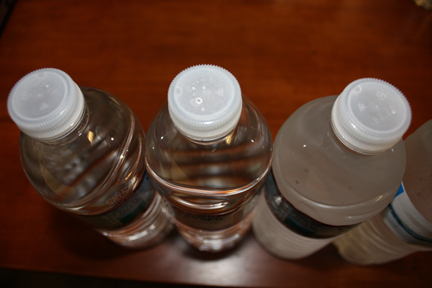 I am sitting at my desk and I just finished drinking a
bottle of water. I have been doing a lot of thinking about water lately. Just
yesterday, I was working in my yard. I was hot and sweaty, covered with dirt
from head to toe, and very thirsty. I did not have a bottle of water with me at
the time, so I did something that was once thought of as ordinary, but now
seems a bit barbaric: I got a drink of water from a spigot! That’s right, I
drank tap water!
I am sitting at my desk and I just finished drinking a
bottle of water. I have been doing a lot of thinking about water lately. Just
yesterday, I was working in my yard. I was hot and sweaty, covered with dirt
from head to toe, and very thirsty. I did not have a bottle of water with me at
the time, so I did something that was once thought of as ordinary, but now
seems a bit barbaric: I got a drink of water from a spigot! That’s right, I
drank tap water!
I
am old enough that I remember when everyone I knew drank tap water. I remember
standing in a long line to get a drink of cold tap water out of a water
fountain when I was a youngster in school. We all thought it was great. When
did it go out of vogue to drink what was free and limitless to paying for a
bottle of water? It all has to do with marketing. In the mid-1970s, the French
bottled mineral water, Perrier, started a marketing push into the United States
that took on soft drinks head to head. Take a look at their early commercials. As people became more health conscious, water became an
alternative to sugary carbonated drinks, and Perrier had a natural carbonation
due to the source of the spring. But Perrier did more than just appeal to a
person’s health. They appealed to a certain lifestyle that began to gain a
foothold in the 1980s. Drinking Perrier Water out of a bottle was trendy and
upscale. But you could get water from a tap for free, so why buy a bottle of
it? That’s when they added a third element that put bottled water over the top.
They began to market against tap water. They claimed that tap water was not a
healthy choice, that the water in your tap was filled with bacteria and toxic
chemicals and that bottled water was pure - why, it came from the earth! The marketing worked. Soon both
Pepsi (Aquafina)
and Coke (Dasani) were bottling water as well. Tap water is supplied by local
utilities that were not in a position to take on the beverage industry in a
commercial war and fight those claims, even though they are held to very strict
standards by government agencies - and their water also came from the earth (I am not sure where else you could get water!) So they were marketing all of this as fact,
knowing that there would be virtually no push back.
So
now I ask myself again, why is it that the water out of the bottle I just drank
better than the water I had yesterday out of the tap? I am asking this while
reading the fine print on the side of the bottle. It says that the purified
water in the bottle is sourced at a public utility! You mean the only
difference between the bottle and the tap is…the marketing! That’s right.
Somewhere along the line, we were all convinced that we should buy what we were
getting for free. Here's the marketing lesson in all of this: if you can convince people that your product or service is not only good for them, but much better than the alternative, you have a marketing message that you can build a brand upon. And people will pay for what they can get for free. (By the way, the water bottle says it is "filtered" water from a utility company. That makes me feel better, how about you?)